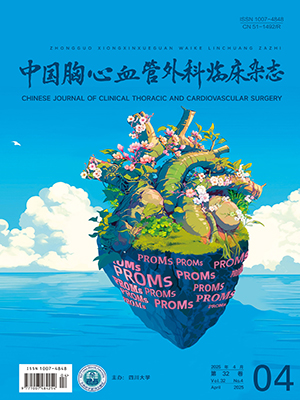| 1. |
Liu P, Qiao WH, Sun FQ, et al. Should a mechanical or biological prosthesis be used for a tricuspid valve replacement? A meta-analysis. J Card Surg, 2016, 31(5): 294-302.
|
| 2. |
Zhu X, Luo Y, Zhang E, et al. Ten-year experience of tricuspid valve replacement with the St. Jude medical valve. Sci Rep, 2018, 8(1): 16654.
|
| 3. |
Rodés-Cabau J, Taramasso M, O'Gara PT. Diagnosis and treatment of tricuspid valve disease: Current and future perspectives. Lancet, 2016, 388(10058): 2431-2442.
|
| 4. |
Garatti A, Nano G, Bruschi G, et al. Twenty-five year outcomes of tricuspid valve replacement comparing mechanical and biologic prostheses. Ann Thorac Surg, 2012, 93(4): 1146-1153.
|
| 5. |
Bevan PJ, Haydock DA, Kang N. Long-term survival after isolated tricuspid valve replacement. Heart Lung Circ, 2014, 23(8): 697-702.
|
| 6. |
De Meester P, Van De Bruaene A, Voigt JU, et al. Outcome and determinants of prognosis in patients undergoing isolated tricuspid valve surgery: Retrospective single center analysis. Int J Cardiol, 2014, 175(2): 333-339.
|
| 7. |
Rossello X, Muñoz-Guijosa C, Mena E, et al. Tricuspid valve replacement with mechanical prostheses: Short and long-term outcomes. J Card Surg, 2017, 32(9): 542-549.
|
| 8. |
Mao B, Sun L, Zhang J, et al. Perioperative factors associated with short- and long-term outcomes after tricuspid valve replacement. Interact Cardiovasc Thorac Surg, 2016, 23(6): 845-850.
|
| 9. |
Chang HW, Jeong DS, Cho YH, et al. Tricuspid valve replacement vs. repair in severe tricuspid regurgitation. Circ J, 2017, 81(3): 330-338.
|
| 10. |
Marquis-Gravel G, Bouchard D, Perrault LP, et al. Retrospective cohort analysis of 926 tricuspid valve surgeries: Clinical and hemodynamic outcomes with propensity score analysis. Am Heart J, 2012, 163(5): 851-858.
|
| 11. |
Raikhelkar J, Lin HM, Neckman D, et al. Isolated tricuspid valve surgery: Predictors of adverse outcome and survival. Heart Lung Circ, 2013, 22(3): 211-220.
|
| 12. |
Chen J, Hu K, Ma W, et al. Isolated reoperation for tricuspid regurgitation after left-sided valve surgery: Technique evolution. Eur J Cardiothorac Surg, 2020, 57(1): 142-150.
|
| 13. |
Songur CM, Simsek E, Ozen A, et al. Long term results comparing mechanical and biological prostheses in the tricuspid valve position: Which valve types are better--mechanical or biological prostheses? Heart Lung Circ, 2014, 23(12): 1175-1178.
|
| 14. |
Chen J, Abudupataer M, Hu K, et al. Risk factors associated with perioperative morbidity and mortality following isolated tricuspid valve replacement. J Surg Res, 2018, 221: 224-231.
|
| 15. |
Litwiński P, Kołsut P, Sitko T, et al. Results and factors associated with adverse outcome after tricuspid valve replacement. Kardiol Pol, 2018, 76(4): 731-739.
|
| 16. |
Zack CJ, Fender EA, Chandrashekar P, et al. National trends and outcomes in isolated tricuspid valve surgery. J Am Coll Cardiol, 2017, 70(24): 2953-2960.
|
| 17. |
Kilic A, Saha-Chaudhuri P, Rankin JS, et al. Trends and outcomes of tricuspid valve surgery in North America: An analysis of more than 50, 000 patients from the Society of Thoracic Surgeons database. Ann Thorac Surg, 2013, 96(5): 1546-1552.
|
| 18. |
Vassileva CM, Shabosky J, Boley T, et al. Tricuspid valve surgery: The past 10 years from the Nationwide Inpatient Sample (NIS) database. J Thorac Cardiovasc Surg, 2012, 143(5): 1043-1049.
|
| 19. |
Enriquez-Sarano M, Messika-Zeitoun D, Topilsky Y, et al. Tricuspid regurgitation is a public health crisis. Prog Cardiovasc Dis, 2019, 62(6): 447-451.
|
| 20. |
Hwang HY, Kim KH, Kim KB, et al. Mechanical tricuspid valve replacement is not superior in patients younger than 65 years who need long-term anticoagulation. Ann Thorac Surg, 2012, 93(4): 1154-1160.
|
| 21. |
Chen Z, Ke Y, Xie X, et al. Outcomes of totally endoscopic beating-heart tricuspid repair in redo cardiac surgery. Heart Lung Circ, 2020, 29(12): 1880-1886.
|
| 22. |
Chen Z, Ke Y, Xie X, et al. Beating-heart totally endoscopic tricuspid valvuloplasty in reoperative cardiac surgery. Ann Thorac Surg, 2019, 107(1): e79-e82.79-82.
|
| 23. |
He BC, Ke YJ, Zhou K, et al. Modified unicaval drainage in reoperative isolated tricuspid valve repair via totally thoracoscopic approach. Perfusion, 2020, 35(7): 649-657.
|
| 24. |
Nakano K, Ishibashi-Ueda H, Kobayashi J, et al. Tricuspid valve replacement with bioprostheses: Long-term results and causes of valve dysfunction. Ann Thorac Surg, 2001, 71(1): 105-109.
|
| 25. |
黄焕雷, 谢旭晶, 卢聪, 等. 三尖瓣位人工机械瓣与生物瓣置换的远期结果. 中国胸心血管外科临床杂志, 2015, 22(5): 418-422.
|




